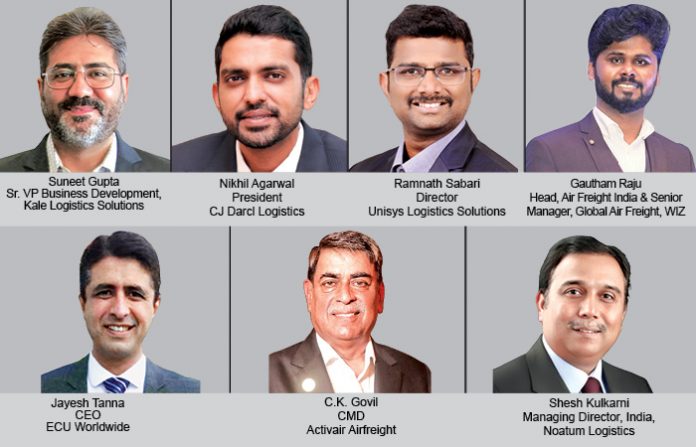Since e-commerce continues to expand and cross-border trade grows, it demands high quality storage and efficient last-mile deliveries. There is need for dedicated warehouses at the airports for perishables and pharma. Blockchain can improve security, minimise cyber risks, delays and enhance supply chain visibility.
Ritika Arora Bhola
With the e-commerce expansion and rise in cross-border trade, there has been pressure on existing infrastructure to handle the surge in volumes being transported, especially during peak season. E-commerce demands high quality storage and efficient last-mile deliveries. There is an urgent need for dedicated warehouses at the airports especially for perishables and pharma products. Only automation and digitalisation have the potential to address these issues and reduce bottlenecks by streamlining processes and enhancing operational efficiency.
Automated cargo handling systems, real-time tracking and AI-powered analytics, blockchain can optimise route planning, reduce manual errors, and speed up cargo processing at airports and warehouses. Digital platforms enable seamless communication between stakeholders, ensuring faster and accurate information flow.
Blockchain technology can improve transparency and security, minimise delays and enhance supply chain visibility. The biggest bottleneck is cyber-security and low-tech adoption risks, which must be addressed. By embracing these technologies, the air cargo industry can overcome existing challenges, improve throughput and deliver faster, more reliable services. CARGOTALK discusses with experts how technology can improve operational efficiency and cost-effectiveness.
Main hurdle is transparency in ops & cybersecurity
Suneet Gupta, Sr. VP Business Development, Kale Logistics Solutions
AI, cargo community systems, ICS2.0, and sustainability along with surge in e-commerce has strengthened the industry’s growth. As on date, the main bottleneck is transparency in operations and cybersecurity risks. All of them can be overcome if the tech adoption rate is high. Many have not adopted due to a notion that all tech-related platforms come with a high investment. And this is followed by targeted outreach programmes and PoCs to drive familiarity to encourage adoption and seamless acceptance. This must be a global initiative and not limited to select developed regions.”
Global tensions, volatile fuel prices, key issues
Nikhil Agarwal, President, CJ Darcl Logistics
Amidst geopolitical tensions, air cargo has emerged as a resilient sector. Alternative routes and use of cargo charters highlights its adaptability to navigate through supply chain disruptions. 3.2 per cent growth in demand this year is testament to the sector’s agility. This increased reliance on cargo highlights need for LSPs to have partnerships with airlines. Exploring strategies to cap fluctuating fuel prices and promoting SAF are the beneficial solutions the sector should foresee. With e-commerce expansion and rise in cross-border trade, there is pressure on existing infrastructure to handle volume surge.”
Inconsistent tech adoption creates inefficiencies
Ramnath Sabari, Director, Unisys Logistics Solutions
Rising e-commerce demand led carriers to invest in specialised facilities and enhance last-mile delivery. JVs and interlining have expanded networks and improved resource use. Digitalisation efforts have augmented capacity management and operational efficiency. Geopolitical tensions and economic uncertainties force cargo rerouting, adding pressure on limited capacity. Hurdles, such as evolving tariffs and de minimis changes, disrupt trade flows and impact e-commerce. Digital integration gaps create inefficiencies due to inconsistent adoption of digital tools.”
No space for big aircraft at regional airports
Gautham Raju, Head, Air Freight India & Senior Manager, Global Air Freight, WIZ
Hike in oil prices due to geopolitical tensions and imposition of tariffs are the main concerns. Non-user-friendly airports for cargo such as Chennai Airport where there is no proper infra to cater the inflow and outflow is another challenge. There is no space for widebody aircraft to be parked in Chennai following which cargo is diverted to Bengaluru or Hyderabad. Since India is aiming to achieve 10 MMT by 2030, govt and regulatory bodies should join hands and impose new rules for EoDB. Imparting training to supply chain users will provide error-free environment.”
Most airports with cargo capability are underutilised
Jayesh Tanna, CEO, ECU Worldwide
There is lack of smooth integration between freighters and passenger services. Most airports have poor link with other forms of transportation. Less than 2 per cent of global freight volumes are moved by air and a shift in goods movement from sea to air due to any supply chain disruptions may lead to a rise in volumes. Even though India has 70 airports with cargo capabilities, most of them are underutilised. Setting up of SEZs near airports for exports will foster a climate for cargo-centric airline expansions and faster customs procedures and clearances.”
Airlines adjust fleets to manage demand hike
C.K. Govil, CMD, Activair Airfreight
The industry has accelerated adoption of AI, blockchain, and IoT to enhance visibility, improve tracking, and optimise logistics. Digital platforms and e-AWBs have become widespread. Airlines have adjusted their cargo fleets, converted pax aircraft into freighters and optimised scheduling to manage demand fluctuations. Operators have explored alternative routes and secondary hubs to avoid bottlenecks due to geopolitical tensions. The government and industry bodies have worked together to implement policies to ensure smoother trade flows.”
Air cargo, logistics face demand-supply gap
Shesh Kulkarni, Managing Director, India, Noatum Logistics
Adoption of changing times and dynamic situations are the skills of the industry. As only through adaption can they stay relevant to the challenges and disruptions of the trade and continue to deliver value. The challenges faced by air cargo and logistics industry are fuelled by evolving supply- demand situation. For a change there are no regulatory hurdles and infra is up to date. Building robust engagement platforms between various manufacturing industries, authorities, carriers and forwarders is a must. There should be period exchange between them. This will help each other understand, appreciate and plan better and create a win-win situation.”















